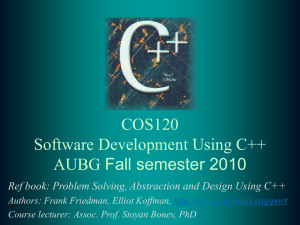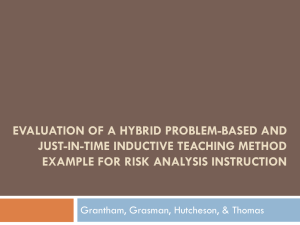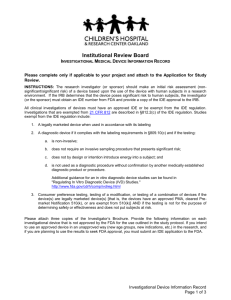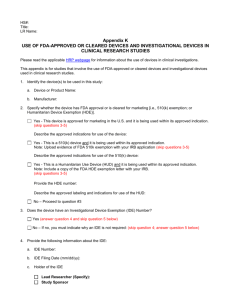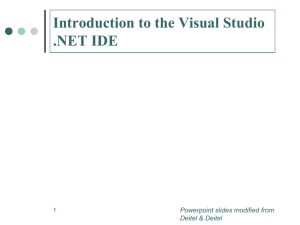SACS Outcomes Assessment Report Guide
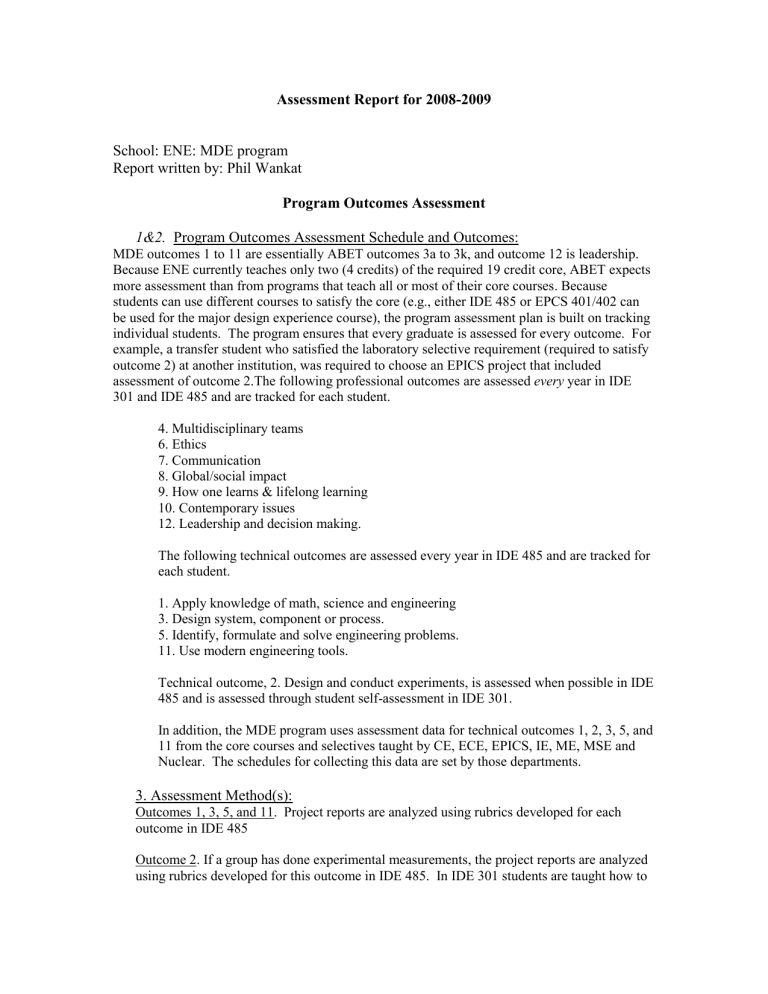
Assessment Report for 2008-2009
School: ENE: MDE program
Report written by: Phil Wankat
Program Outcomes Assessment
1&2.
Program Outcomes Assessment Schedule and Outcomes:
MDE outcomes 1 to 11 are essentially ABET outcomes 3a to 3k, and outcome 12 is leadership.
Because ENE currently teaches only two (4 credits) of the required 19 credit core, ABET expects more assessment than from programs that teach all or most of their core courses. Because students can use different courses to satisfy the core (e.g., either IDE 485 or EPCS 401/402 can be used for the major design experience course), the program assessment plan is built on tracking individual students. The program ensures that every graduate is assessed for every outcome. For example, a transfer student who satisfied the laboratory selective requirement (required to satisfy outcome 2) at another institution, was required to choose an EPICS project that included assessment of outcome 2.The following professional outcomes are assessed every year in IDE
301 and IDE 485 and are tracked for each student.
4. Multidisciplinary teams
6. Ethics
7. Communication
8. Global/social impact
9. How one learns & lifelong learning
10. Contemporary issues
12. Leadership and decision making.
The following technical outcomes are assessed every year in IDE 485 and are tracked for each student.
1. Apply knowledge of math, science and engineering
3. Design system, component or process.
5. Identify, formulate and solve engineering problems.
11. Use modern engineering tools.
Technical outcome, 2. Design and conduct experiments, is assessed when possible in IDE
485 and is assessed through student self-assessment in IDE 301.
In addition, the MDE program uses assessment data for technical outcomes 1, 2, 3, 5, and
11 from the core courses and selectives taught by CE, ECE, EPICS, IE, ME, MSE and
Nuclear. The schedules for collecting this data are set by those departments.
3. Assessment Method(s):
Outcomes 1, 3, 5, and 11. Project reports are analyzed using rubrics developed for each outcome in IDE 485
Outcome 2. If a group has done experimental measurements, the project reports are analyzed using rubrics developed for this outcome in IDE 485. In IDE 301 students are taught how to
do self-assessments, are provided with rubrics for outcome 2, and turn in a self-assessment as a homework assignment.
Outcome 4. In IDE 301 peer ratings were collected for a team project. In IDE 485 peer ratings were collected for team preparation for a debate and teams were analyzed for their work together in the design project.
Outcome 6. In IDE 301 a multiple choice homework assignment requires use of the NSPE
Code of Ethics to analyze various scenarios. This assignment is evaluated based on both the answers and the code items used to support the answers. In IDE 485 the team written reports for the debate were analyzed with the aid of a rubric.
Outcome 7. In IDE 301 oral communications were assessed for a short “elevator” speech using a rubric designed for an informal presentation. In IDE 485 the debate was rated by a panel of three professors. Also, the oral presentations for the design project were rated by a panel of three professors using rubrics. A series of short papers were assessed with rubrics in
IDE 301 (1 team and 2 individual papers) and in IDE 485 (3 team reports and 1 individual paper).
Outcomes 8 and 10. With the aid of separate rubrics, a worksheet was analyzed in IDE 301 for both outcomes, and the written debate paper was analyzed in IDE 485 for both outcomes.
Outcome 9. Different worksheets were completed in class in IDE 301 and IDE 485. The
IDE 301worksheet emphasized the results of the learning style inventory while the IDE 485 worksheet emphasized a plan for learning after college.
Outcome 12. Students were assessed based on a written report on leadership communication and on decision making in IDE 301 and IDE 485, respectively. Individual interviews with questions about extracurricular activities were used in both courses to determine what leadership activities the students were involved in. In IDE 485 the interview was combined with the exit interview for graduating students. Students did a self-assessment with evidence of their leadership, mainly in extracurricular activities, in IDE 301.
4. Assessment Results:
As an example, the summary page for IDE 485 is presented on the next page.
5. Conclusions and/or Improvement Action Plans: With the exception of outcome 12
(leadership) students are meeting the outcomes. For leadership we are strongly encouraging students to become involved in leadership activities. One way to do this is to discuss obtaining jobs earlier in the curriculum and note the strong connection between leadership activities and job offers. All outcomes will be assessed every year. In addition, the technical outcome assessment results obtained by the other schools of engineering will be used.
6. Evaluation of Improvement Action Plans: Decision making was added to the rubric for leadership after discussions with the E2IAC. A lecture and homework assignment on decision making was added to IDE 485. The first part of the homework – reflection on previous decision making – was successful, but use of a formal decision making tool for a current decision was not. Apparently, the instructions were not clear. In the future the instructions will be explicit that one of the tools discussed in lecture must be employed.
Outcomes/Students A
IDE 485, Spring 2009. Assessment Summary
Professors David Radcliffe and Phillip Wankat
B C D E F G H I J K L M 1 N
S- S- S- S- S- S- S- S- S- S- S- S- S- S- 1. Know math, sci, engr.
2Experiments 2
3. Design
A+
S
A+
A+-
A+ A+ A+ A+
S S- S A+
--
S
--
S
--
S-
A+
S-
A+
S-
A+
A+
A+
S-
--
S
4. Teams-design
4. Teams-Debate
Peer Ratings
S A+ S- S S- S- A+ S- S- S S S- A+ S
S S S S S S S S S S S S U 1 S
S- S- S- S- S- S- S- S- S- S- S S- S- S-
S- S- S- S- S- S- S S S S- S- M U 1 S
5. Engr problems
6 Prof/ethical
Debate report
7Communicate
Oral design pres.
7Communicate write design
7Communicate – oral Debate 3
S-
A+
--
S-
A+
--
S-
A+ A+ A+ A+ A+
--
S-
S-
S-
A
S-
A-
S
A-
S-
A+
A+
S-
A+
--
S-
A+
S
S
A+
--
S-
A+
M+
S
A+
--
S
A+
S
7. Write Debate team report
7 write: Decision
HW
8 Impact global societal-debate
9 lifelong learn worksheet
10 Contemp issues
– debate
A+ A+ A+ A+ A+ A+ S S S A+ A+ M U 1 S
A A+ A+ A- S M A+ A+ S- S- M+ A S- S-
S- S-
S- S- S- S- S- S- S S S S- S- M U 1 S
A+
S-
A+
S-
A+
S-
A-
S-
A+
S-
A-
S-
A-
S-
S-
S-
A-
S-
A
S-
S-
S-
A+
M
A-
U 1
S-
S
11. Modern engr tools
12 Leadership
Interview
12 Leadership
Decision HW
S A+ S A+ A+ A+ S A+ A+ A+ A+ A+ A+ S
S M+
M+
A-
A-
M
A
A
A
A
A-
A
M
M
A
A
S
M+
S
A-
A
M+
A-
A
M
M+
A-
M+
A-
M-
M+
A-
S
A+
1. According to other team members, student M did not work on the debate preparation.
2. Two of the 3 design teams did experimental measurements in the project at Caterpillar and were ranked on outcome 2.
3. There were 3 teams and one team was chosen by lot to not be involved in the oral debate.
Scoring code: S = Superior, A = Acceptable, M = Marginal, U = Unacceptable.
Program Educational Objectives Assessment
1.
Program Educational Objectives Assessment Schedule:
The first graduate from the MDE program graduated in May 2007. Because the number of graduates is very small, structured telephone interviews of alumni and of employers will be used in 2009. Educational objectives for the MDE program will be measured in summer 2009 and summer 2012.
2.
Assessment Method(s):
3.
Assessment Results:
4.
Conclusions and/or Improvement Action Plans:
5.
Evaluation of Improvement Action Plans:
6.
Process Evaluation:
Engineer of 2020 Update
The Engineering Education Industrial Advisory Council (E2IAC) and the faculty were separately polled for the top four items in each pillar. In the Abilities pillar the E2IAC combined teamwork, works effectively in diverse and multicultural environments, and works effectively in the global engineering profession into a single category that they voted to be most important. The E2IAC voted communication as 2 nd
, and had decisionmaking and synthesizes engineering business & social perspectives tied for 3 rd
. The faculty voted diversity as most important, leadership as second, recognizing and managing change as 3 rd
and communication as 4 th
. In the MDE outcomes Leadership and
Decision-Making are coupled into the Leadership outcome. Thus, the program has outcomes and assessment procedures developed on these two abilities plus for the communication, teamwork, and globalization abilities. Based on our assessment of these outcomes, students in the program are generally at the acceptable or higher level in these outcomes except in the areas of leadership and decision making where a number of students are in the marginal range. Outcomes and metrics for the other abilities have not been developed yet.
In the Knowledge Areas pillar the integration of analytical, problem solving and design skills was ranked first by both E2IAC and the faculty. The E2IAC had analytical skills and multidisciplinarity tied for second while the faculty rated multidisciplinarity third.
Open-ended design & problem solving was ranked 4 th by the E2IAC and 2 nd by the faculty. Engineering fundamentals were ranked 4 th
by the faculty. MDE outcomes and established assessments measure various aspects of all the ranked knowledge areas
except for multidisciplinary. In the items that correspond to outcomes, students are performing at the acceptable and superior levels.
In the Qualities pillar the E2IAC ranked ethically responsible as most important (faculty rating was 3 rd
), innovative and strong work ethic were tied for 2 nd
(faculty voted these as most important and 4 th , respectively), and curious and persistent learners was 4 th . The faculty voted adaptable in a changing environment as 3 rd
. The MDE program has outcomes and assessment procedures for the ethical and continuous learner qualities.
Most students are performing at the acceptable or superior levels. Outcomes and metrics for the other qualities have not been developed yet; however, anecdotal evidence supports achievement of strong work ethics.
The next set of attributes to be incorporated into the MDE program are the top ranked items in each pillar that are not currently incorporated in the program. These are: “works effectively in diverse & multicultural environments”, “multidisciplinarity within and beyond engineering,” and “innovative.”
BALOTS Update
The MDE and IDES programs are up-to-date in BALOTS.
